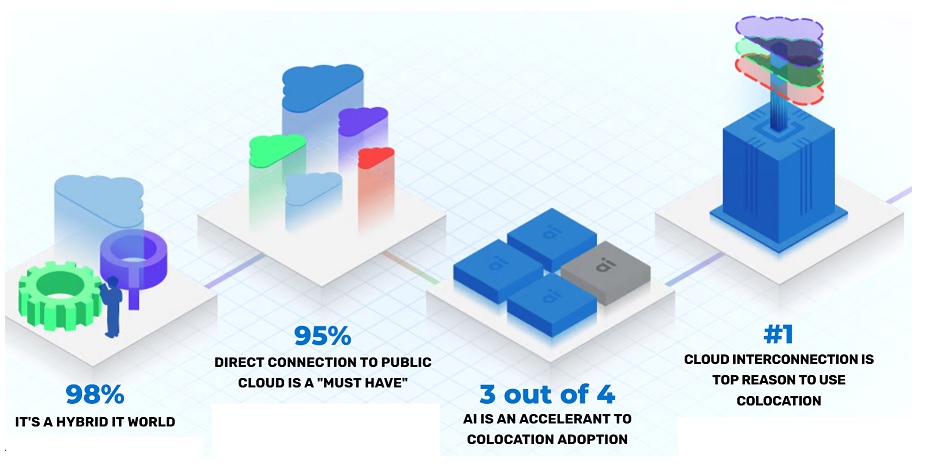More than ever, IT executives have options for strategically locating computing resources across multiple environments, with an eye toward interconnected digital ecosystems that deliver value, performance and flexibility. These specialized digital ecosystems are being strategically designed via combinations of colocation, cloud and on-premises resources aligned with business objectives.
The 2024 State of the Data Center Report from CoreSite shows that although C-suite confidence in the economy remains high, a VUCA (volatile, uncertain, complex, ambiguous) environment has many business leaders proceeding with caution when it comes to their IT and data ecosystems, with an emphasis on cost control and predictability, flexibility and risk management.
However, this cautious approach also must accommodate a growing volume of resource-intensive artificial intelligence (AI) and other high-density workloads critical to organizational growth and innovation. The result of this dichotomy is an accelerated embrace of hybrid IT ecosystems to support varying types of data and workload needs.
Specifically, 98% of organizations say they have currently adopted or plan to adopt a hybrid model using colocation, private cloud and public cloud to manage their workloads.

Source: CoreSite
"The 2024 data demonstrates that IT leaders are increasingly relying on hybrid IT environments to support business objectives, including better cost control and predictability, and to efficiently deploy specific workloads to maximize benefits," said Juan Font, CoreSite President and CEO and American Tower Senior Vice President. "Underscored by the evolving needs of AI and other high-density workloads, modern hybrid IT strategies allow for the type of flexibility that can reduce infrastructure footprints and focus IT resources and talent on growth, while delivering the performance organizations need to remain competitive."
Key insights from this year's report include:
Connection Reigns Supreme
Companies need to directly connect to the cloud and interconnect systems and locations to transfer large-scale amounts of data, while keeping latency, cost, security and quality in mind. In fact, cloud interconnection was the No. 1 reason for using colocation for nearly half of the 22 workloads included in the survey. However, only 31% of respondents say their current colocation provider offers interconnection to a variety of cloud providers.
Additionally, 95% of respondents said the ability of colocation providers to offer native, direct connections to the major cloud providers is important, with 69% citing it as very important.
A Public Cloud Exodus
The public cloud has historically been seen as an essential platform to replace legacy technology or quickly add new capabilities to improve agility and flexibility. However, "cloud smart" hybrid IT infrastructure environments are increasingly valued over an "all in" cloud approach for their ability to effectively and efficiently address cost concerns while meeting performance and compliance requirements.
Most participants in the survey say they have considered a move from public cloud to colocation across 22 different workloads, led by generative AI (GenAI) applications, BI/analytics, and IoT connectivity and management. Compared with the 2023 study, the use of public cloud is trending down across all workloads.
AI Is Hybrid IT Accelerant
Heightened use of AI — which requires more computing resources and high data volumes — is forcing IT leaders to re-evaluate options for hosting these and other high-density workloads within current budget constraints. The 2024 results show a shift of AI-specific workloads from on-prem environments, primarily to colocation data centers.
Additionally, at least three-quarters of respondents in this year's survey said they are considering moving AI-related workloads from the public cloud to a colocation data center, including GenAI applications (91%), chatbots (81%), predictive analytics (79%) and augmented AI applications (76%).
"IT executives have more options than ever for locating computing resources, and the CoreSite 2024 State of the Data Center Report demonstrates how highly customized hybrid environments that include colocation are becoming the option of choice for organizations that must remain highly competitive while continually managing cost predictably," said John Gallant, Enterprise Consulting Director at CIO. "These often-competing pressures only will become more salient with AI's explosive growth in the coming years. Adopting an ecosystem — and regularly optimizing that ecosystem — with a mix of colocation, private cloud and public cloud capabilities is a trend that likely will continue to remain dominant in the coming years."
Methodology: The report is based on a quantitative survey of 300 CIOs, CTOs and other IT decision-makers, plus in-depth interviews with seven senior technology executives from financial services, healthcare, retail and SaaS organizations. Foundry, an IDG, Inc. company, conducted the research.
